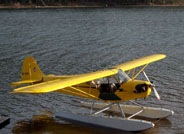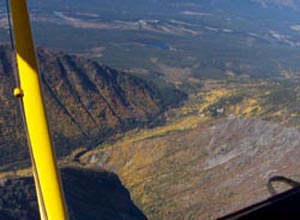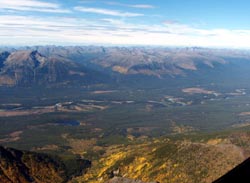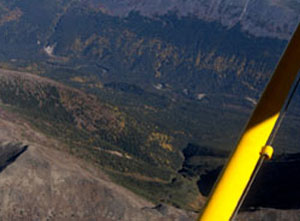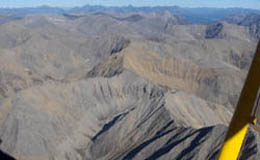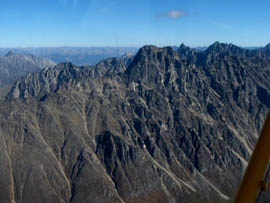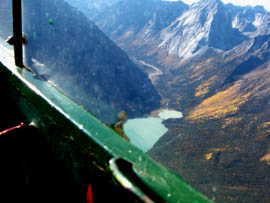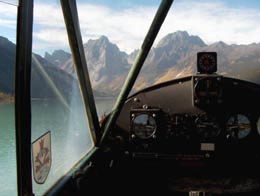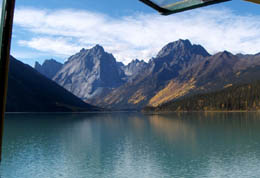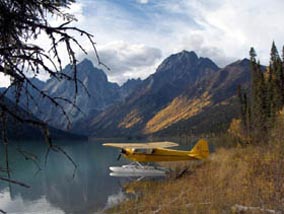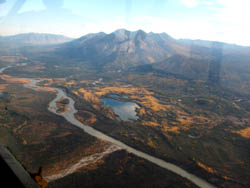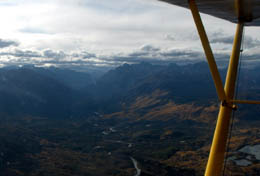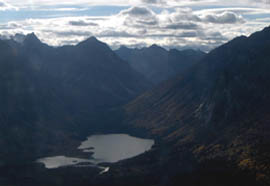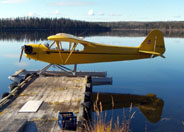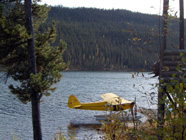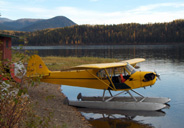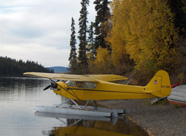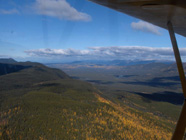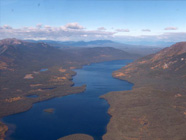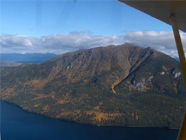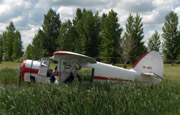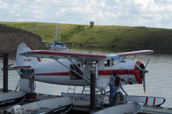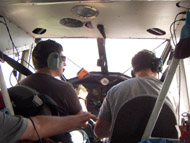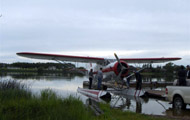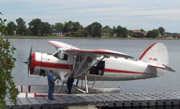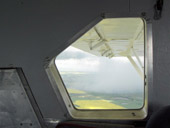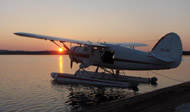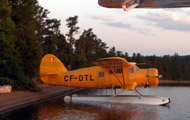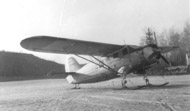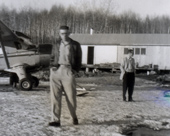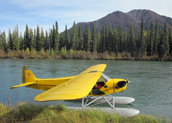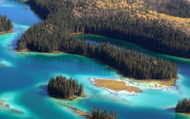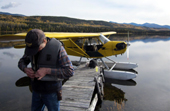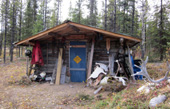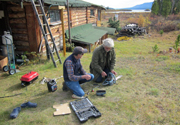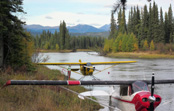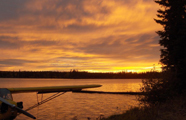
 Canada's North West |
|
|
Summer 2007 - J3 Flight to Nahanni Park
(Text by Dave Hilchie) ...did this trip on Thursday and these are positively the last pictures of the season. Glacier Lake was where Bill Eppler and Joe Mulholland spent the winter trapping in 1935/38. Their cabin was found burned to the ground and they were never seen again, one of the Nahanni mysteries. The consensus now is that they drowned in the Nahanni trying to raft out after breakup the spring of 1936.(See R.M. Patterson's book "Dangerous River" for details.) |
|
Heading North up the Hyland River valley. |
View across the valley. |
|
Hyland River tributary creek flowing out of Ceaser Lake. |
Mountains bordering the west side of the Flat River valley. Ragged Range of the Nahanni visible on the horizon.View across the valley. |
|
The Ragged Range. Now truly in the Nahanni. |
Circling down over Glacier Lake. |
|
On the water - east end of Glacier Lake. Mt. Harrison Smith at the end. A long distance to taxi. Landed on the east end due to glassy water at the west. |
This is within the proposed Nahanni Park boundary extension and when finalized, no more aircraft access permitted. |
|
Wonder when the last Piper Cub flew in here? Ashore for lunch. Clouds starting to move in from the west. |
View south climbing out from Glacier Lake. Nahanni River below and Rabbit Kettle Lake to the west of it. This is within the existing Park boundary. |
|
Weather coming in from the west. Looking northwest up the famous Rabbit Kettle River
towards it's source near the Yukon border. Turbulent. |
Hole-in-the-wall lake on north side of the pass. No landings permitted. It's always turbulent in here. Pass and lake named by George Dalziel who hiked through here in early 1930's - unmapped at the time. |
Ed. Note: I asked Dave how he navigated from Watson Lake to the Nahanni and back. I like his response:
Re Glacier Lake: I flew a direct route up there by GPS (my small hand held) but that means climbing to 10 thou or so and hence I came back the more usual route for Watson Lake traffic, which is down the Nahanni to Hole-in-the-Wall pass, through the pass to the Flat river, across the Flat to the pass over Lucky Lake and then down the Coal River valley to near Stuart Lake. From thence over the Green River pass to the Hyland River valley and then across the hills north of Watson to the lake. You can see the whole route on the Fort Simpson VFR nav chart.
Glacier is at approximately 62°10'N/127°33'W. One can see how relatively close it is to the Nahanni Range Road
(Yukon #10) and why John Harris and Vivien Loughheed kept trying to hike through by that route.
All Photos by David Hilchie

Dave Hilchie's Piper Cub at Watson Lake, Yukon Territory
|
Although Dave Hilchie (see the YUL page) is retired and living on Vancouver Island, he still summers at his cabin on Watson Lake. 60°05'N/128°45'W certainly qualifies as being North. Being on a lake and having your own Piper Cub on floats - it doesn't get much better!
"Watson Lake is about five miles long and at 2300 feet above sea level, so will accommodate anything flying today comfortably and I have done circuits in Jackfish Bay at the end of the lake which is about a half mile long. But on a hot summer day with no wind the Cub is fairly close to the trees climbing out. The bay is set in a bit of a bowl with rising terrain on three sides. |

2010 More Pictures from Dave Hilchie's Piper Cub in the Yukon Territory

2010 - On Flying a Piper J3
|
... What I've always needed with that Cub is about ten gallons more fuel capacity for a reasonably comfortable cross country range in such sparsely settled area. I can lean it out to burn about 4.5 gal/hr under ideal conditions but its not prudent to rely on that in flight planning. Those little Continentals are prone to carb ice for example and if I have to put on carb heat, the consumption goes up to 5 gal/hr. So I use that for flight planning and given the existing 20 gal total fuel capacity (1 ten gal fuselage tank and a ten gal wing tank) that gives me 3 hrs plus 1 reserve, which at a still air ground speed of 83 mph at 2300 rpm is only about 250 miles - 320 miles and the tank float is bouncing on the bottom. |

Norseman Adventure - 2010
From Alberta, East to the annual Norseman gathering in Red Lake Ontario, and back again.
Dave's Hilchie's summer adventure: |
|
All Photos by David Hilchie |
The Norseman
"The Noorduyn Norseman is a Canadian single-engine bush plane designed to operate from unimproved surfaces. Norseman aircraft are known to have been registered and/or operated in 68 countries throughout the world and also have been based and flown on the Arctic and Antarctic continents. The Norseman was the plane that Glenn Miller was flying in when it disappeared somewhere over the English Channel. (from Phil Gies, webmaster) If you are from Canada's North, then you have seen and heard Canada's quintessential bushplane, the Noorduyn Norseman. This workhorse of the North would carry freight and passengers to many of the more remote and inhospitable places over the entire planet. I have a special affinity for the Norseman; my Dad worked for McIsaac (later Midwest) Diamond Drilling out of Flin Flon in the 1950's and had many trips to drilling sites scattered in the boreal forests covering Northern Manitoba. I recall a story he used to tell of trying to take off from Schist Lake on a float equipped Norseman at full gross take-off weight. Seems it took pilot Harvey Evans 3 attempts to finally take off. My father said he was starting to get a little concerned. So was my Dad... When I began my ATC career I worked at Cartierville airport (CYCV) which was the home of Noorduyn. You could still see one of the Noorduyn buildings when I was there in 1967-68. Although I never had a ride in a Norseman, Dave Hilchie certainly did! Here are a couple of Norseman photos from my collection |
|
|
|
|

2011 Latest pictures from Dave Hilchie's Piper Cub in the Yukon Territory

And of course, legends of the North
|
The Headless Valley
It's a fancy place that oldtimers dream about... Some said the "valley was full
of gold and some said it was hot as hell owing to the warm springs... It had a wicked name too, for at least a
dozen folks went in and never came out... Indians said it was the home of devils... |
|
The Mad Trapper Of Rat River
In February of 2005, Corporal R.G. McDowell (Rtd) passed away at the age of 94. His passing severed the final link to the famous manhunt for Albert Johnson which took place in the Western Arctic during the winter of 1931/32. The story is commonly known as; "THE MAD TRAPPER OF RAT RIVER" and captured the imagination of readers and listeners
throughout North America as they followed the daily/weekly newspapers dispatches and daily accounts on the relatively new medium of radio. The investigation began at a trapper's cabin near the Rat River on January 10 and the manhunt ended in a gun battle on the Eagle river on February 17 - a story of incredible tenacity, cunning and hardship in the bitter cold. |

